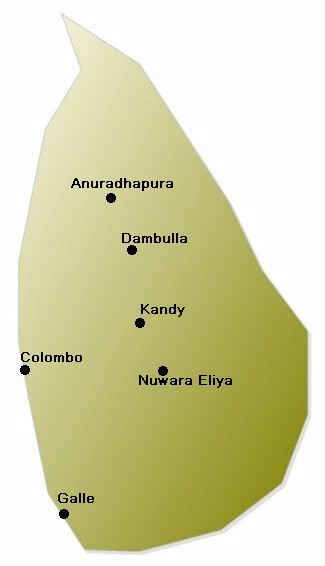Sri Lanka: Map/Geography


For a small island, Sri Lanka has many nicknames: Serendib, Ceylon, Teardrop of
India, Resplendent Isle, Island of Dharma, Pearl of the Orient. This colourful
collection reveals its richness and beauty, and the intensity of affection that it
has evoked in visitors. For centuries it seduced travellers, who returned home with
enchanting images of a languorous tropical isle of such deep spirituality and serenity
that it entered the Western imagination as a Tahiti of the East.
Sri Lanka, an island in the Indian Ocean is located to the south of the
Indian subcontinent. The total land area is 65,610 sq. km. and is astonishingly varied. A length of
445 km. and breadth of 225 km. encompasse beautiful tropical beaches, verdant
vegetation, ancient monuments and a thousand delights to please all tastes.
The relief features of the island consist of a mountainous mass somewhat south
of the centre, with height exceeding 2,500 metres, surrounded by broad plains.
Palm fringed beaches surround the island and the sea temperature rarely falls
below 27 Degrees.
In the lowlands the climate is typically tropical with an average temperature
of 27 Degrees in Colombo. In the higher elevations it can be quite cool with
temperatures going down to 16 Degrees at an altitude of nearly 2,000 metres.
Bright, sunny warm days are the rule and are common even during the height
of the monsoon - climatically Sri Lanka has no off season. The south west
monsoon brings rain mainly from May to July to the western, southern and central
regions of the island, while the north-east monsoon rains occur in the northern
and eastern regions in December and January.
Sri Lanka is mainly an agricultural country. The chief crop is rice with which
the country is almost self sufficient. Tea, rubber and coconut are also important
agricultural crops, with tea being a major foreign exchange earner. In addition,
other crops of importance are cocoa and spices such as cinnamon, cardamom, nutmeg,
pepper and cloves. Fruit and vegetables, native to both tropical and temperate regions,
grow well in Sri Lanka. Sri Lanka is also a major exporter of precious and semi-precious
stones. Within the last few years remittances from Sri Lankans employed abroad have
contributed a large share towards foreign exchange.
The last three decades have seen tourism emerge as an important industry. There has
also been a rapid growth in manufacturing industries which offer a wide range of export
goods such as petroleum products, leather goods, ready made garments and electronic
equipment.
The Democratic Socialist Republic of Sri Lanka is a free, independent and sovereign
nation. A system of administration through provincial councils was introduced in 1988.
Legislative power is exercised by Parliament, elected by universal franchise on a
proportional representation basis. Executive power of the people, including defence,
is exercised by the President, who is also elected by the people.
Sri Lanka is the world's leading producer of high quality tea, which is our main export.
Most itineraries which include hill country resorts also include a visit to a tea estate
and factory to see production and processing which is done in some of the most scenic
areas of the island.

